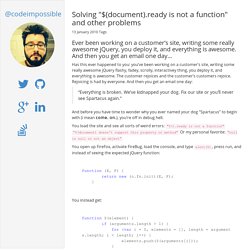

Solving "$(document).ready is not a function" and other problems. Ever been working on a customer’s site, writing some really awesome jQuery, you deploy it, and everything is awesome.

And then you get an email one day… Has this ever happened to you: you’ve been working on a customer’s site, writing some really awesome jQuery flashy, fadey, scrolly, interactivey thing, you deploy it, and everything is awesome. The customer rejoices and the customer’s customers rejoice. Rejoicing is had by everyone. And then you get an email one day: “Everything is broken. And before you have time to wonder why you ever named your dog “Spartacus” to begin with (i mean come. on.), you’re off in debug hell.
You load the site and see all sorts of weird errors: "$().ready is not a function" "$(document) doesn't support this property or method" Or my personal favorite: "null is null or not an object" You open up FireFox, activate FireBug, load the console, and type alert($), press run, and instead of seeing the expected jQuery function: You instead get: Or even: DOH! ECMAScript 6 support in Mozilla. ECMAScript 2015 (6th Edition) is the current version of the ECMAScript Language Specification standard.

Commonly referred to as "ES6", it defines the standard for the JavaScript implementation in SpiderMonkey, the engine used in Firefox and other Mozilla applications. Code-named "ES.next" or "Harmony", the first working draft (based on ECMAScript 5.1) was published on July 12, 2011 as "ES.next". In August 2014, the ECMAScript 6 draft specification was feature frozen and went through a stabilization and bug fixing period.
Finally, ECMA-262 Edition 6 got officially approved and published as a standard on June 17, 2015 by the ECMA General Assembly. It will also appear as the international industry standard ISO/IEC 16262:2016. A PDF and HTML version of the standard can be freely downloaded on ecma-international.org. A channel for feedback on ECMAScript standards is es-discuss. Already supported by Firefox Standard library Additions to the Array object New Math functions New Promise object Functions. » ECMAScript 6. The limits of my language mean the limits of my world. – Ludwig Wittgenstein For the past few months I’ve been exclusively writing ECMAScript 6 code by taking advantage of transpilation to a currently supported version of JavaScript.

ECMAScript 6, henceforth ES6 and formerly ES.next, is the latest version of the specification. As of August 2014 no new features are being discussed, but details and edge cases are still being sorted out. It’s expected to be completed and published mid-2015. Adopting ES6 has simultaneously resulted in increased productivity (by making my code more succinct) and eliminated entire classes of bugs by addressing common JavaScript gotchas.
More importantly, however, it’s reaffirmed my belief in an evolutionary approach towards language and software design as opposed to clean-slate recreation. This should be fairly obvious to you if you’ve been using CoffeeScript, which set out to focus on the good parts of JS and hide the broken ones. . # The module syntax works for. ECMAscript 6 Lessons - Screencast Video Tutorials @eggheadio. Lukehoban/es6features. Read Understanding ECMAScript 6. Introduction The JavaScript core language features are defined in a standard called ECMA-262.

The language defined in this standard is called ECMAScript, of which the JavaScript in the browser and Node.js environments are a superset. While browsers and Node.js may add more capabilities through additional objects and methods, the core of the language remains as defined in ECMAScript, which is why the ongoing development of ECMA-262 is vital to the success of JavaScript as a whole. In 2007, JavaScript was at a crossroads. The popularity of Ajax was ushering in a new age of dynamic web applications while JavaScript hadn’t changed since the third edition of ECMA-262 was published in 1999.
The scope of the ECMAScript 4 changes caused a rift to form in TC-39, with some members feeling that the fourth edition was trying to accomplish too much. In 2008, Brendan Eich, the creator of JavaScript, announced that TC-39 would focus its efforts on standardizing ECMAScript 3.1. Who This Book is For. ECMAScript 6 support in Mozilla. JavaScript. JavaScript (JS) is a lightweight, interpreted, or just-in-time compiled programming language with first-class functions. While it is most well-known as the scripting language for Web pages, many non-browser environments also use it, such as Node.js, Apache CouchDB and Adobe Acrobat.
JavaScript is a prototype-based, multi-paradigm, dynamic language, supporting object-oriented, imperative, and declarative (e.g. functional programming) styles. Read more about JavaScript. This section is dedicated to the JavaScript language itself, and not the parts that are specific to Web pages or other host environments. For information about APIs specific to Web pages, please see Web APIs and DOM. JavaScript.